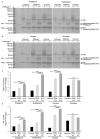Development of an Enhanced High-Yield Influenza Vaccine Backbone in Embryonated Chicken Eggs
- PMID: 37631932
- PMCID: PMC10459923
- DOI: 10.3390/vaccines11081364
Development of an Enhanced High-Yield Influenza Vaccine Backbone in Embryonated Chicken Eggs
Abstract
Vaccination is an efficient approach to preventing influenza virus infections. Recently, we developed influenza A and B virus vaccine backbones that increased the yield of several vaccine viruses in Madin-Darby canine kidney (MDCK) and African green monkey kidney (Vero) cells. These vaccine backbones also increased viral replication in embryonated chicken eggs, which are the most frequently used platform for influenza vaccine manufacturing. In this study, to further increase the viral titers in embryonated chicken eggs, we introduced random mutations into the 'internal genes' (i.e., all influenza viral genes except those encoding the hemagglutinin and neuraminidase proteins) of the influenza A virus high-yield virus backbone we developed previously. The randomly mutated viruses were sequentially passaged in embryonated chicken eggs to select variants with increased replicative ability. We identified a candidate that conferred higher influenza virus growth than the high-yield parental virus backbone. Although the observed increases in virus growth may be considered small, they are highly relevant for vaccine manufacturers.
Keywords: eggs; high yield; influenza A virus; vaccine.
Conflict of interest statement
Y.K. has received speaker’s honoraria from Toyama Chemical and Astellas Inc. and grant support from Chugai Pharmaceuticals, Daiichi Sankyo Pharmaceutical, Toyama Chemical, Tauns Laboratories, Inc., Otsuka Pharmaceutical Co., Ltd., Denka Seiken Co., Ltd., and Shionogi & Co., Ltd. Y.K. and G.N. are co-founders of FluGen. The other authors declare no conflict of interest.
Figures




References
-
- Health O.W. Fact Sheet: Influenza (Seasonal) [(accessed on 9 July 2019)]. Available online: http://www.who.int/en/news-room/fact-sheets/detail/influenza-(seasonal)
-
- Iuliano A.D., Roguski K.M., Chang H.H., Muscatello D.J., Palekar R., Tempia S., Cohen C., Gran J.M., Schanzer D., Cowling B.J., et al. Estimates of global seasonal influenza-associated respiratory mortality: A modelling study. Lancet. 2018;391:1285–1300. doi: 10.1016/S0140-6736(17)33293-2. - DOI - PMC - PubMed
Grants and funding
LinkOut - more resources
Full Text Sources

